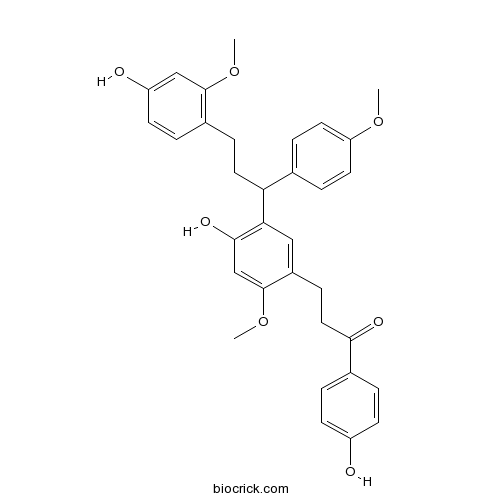Cochinchinenin CCAS# 956103-79-0 |

Quality Control & MSDS
3D structure
Package In Stock
Number of papers citing our products

| Cas No. | 956103-79-0 | SDF | Download SDF |
| PubChem ID | 23634528 | Appearance | Powder |
| Formula | C33H34O7 | M.Wt | 542.62 |
| Type of Compound | Chalcones | Storage | Desiccate at -20°C |
| Solubility | Soluble in Chloroform,Dichloromethane,Ethyl Acetate,DMSO,Acetone,etc. | ||
| Chemical Name | 3-[4-hydroxy-5-[3-(4-hydroxy-2-methoxyphenyl)-1-(4-methoxyphenyl)propyl]-2-methoxyphenyl]-1-(4-hydroxyphenyl)propan-1-one | ||
| SMILES | COC1=CC=C(C=C1)C(CCC2=C(C=C(C=C2)O)OC)C3=C(C=C(C(=C3)CCC(=O)C4=CC=C(C=C4)O)OC)O | ||
| Standard InChIKey | SLJWKFROLINAGW-UHFFFAOYSA-N | ||
| Standard InChI | InChI=1S/C33H34O7/c1-38-27-14-7-21(8-15-27)28(16-9-23-6-13-26(35)19-32(23)39-2)29-18-24(33(40-3)20-31(29)37)10-17-30(36)22-4-11-25(34)12-5-22/h4-8,11-15,18-20,28,34-35,37H,9-10,16-17H2,1-3H3 | ||
| General tips | For obtaining a higher solubility , please warm the tube at 37 ℃ and shake it in the ultrasonic bath for a while.Stock solution can be stored below -20℃ for several months. We recommend that you prepare and use the solution on the same day. However, if the test schedule requires, the stock solutions can be prepared in advance, and the stock solution must be sealed and stored below -20℃. In general, the stock solution can be kept for several months. Before use, we recommend that you leave the vial at room temperature for at least an hour before opening it. |
||
| About Packaging | 1. The packaging of the product may be reversed during transportation, cause the high purity compounds to adhere to the neck or cap of the vial.Take the vail out of its packaging and shake gently until the compounds fall to the bottom of the vial. 2. For liquid products, please centrifuge at 500xg to gather the liquid to the bottom of the vial. 3. Try to avoid loss or contamination during the experiment. |
||
| Shipping Condition | Packaging according to customer requirements(5mg, 10mg, 20mg and more). Ship via FedEx, DHL, UPS, EMS or other couriers with RT, or blue ice upon request. | ||
| Targets | Antifection |

Cochinchinenin C Dilution Calculator

Cochinchinenin C Molarity Calculator
| 1 mg | 5 mg | 10 mg | 20 mg | 25 mg | |
| 1 mM | 1.8429 mL | 9.2146 mL | 18.4291 mL | 36.8582 mL | 46.0728 mL |
| 5 mM | 0.3686 mL | 1.8429 mL | 3.6858 mL | 7.3716 mL | 9.2146 mL |
| 10 mM | 0.1843 mL | 0.9215 mL | 1.8429 mL | 3.6858 mL | 4.6073 mL |
| 50 mM | 0.0369 mL | 0.1843 mL | 0.3686 mL | 0.7372 mL | 0.9215 mL |
| 100 mM | 0.0184 mL | 0.0921 mL | 0.1843 mL | 0.3686 mL | 0.4607 mL |
| * Note: If you are in the process of experiment, it's necessary to make the dilution ratios of the samples. The dilution data above is only for reference. Normally, it's can get a better solubility within lower of Concentrations. | |||||

Calcutta University

University of Minnesota

University of Maryland School of Medicine

University of Illinois at Chicago

The Ohio State University

University of Zurich

Harvard University

Colorado State University

Auburn University

Yale University

Worcester Polytechnic Institute

Washington State University

Stanford University

University of Leipzig

Universidade da Beira Interior

The Institute of Cancer Research

Heidelberg University

University of Amsterdam

University of Auckland

TsingHua University

The University of Michigan

Miami University

DRURY University

Jilin University

Fudan University

Wuhan University

Sun Yat-sen University

Universite de Paris

Deemed University

Auckland University

The University of Tokyo

Korea University
- (2R)-8-Methylsocotrin-4'-ol
Catalog No.:BCN3737
CAS No.:956103-75-6
- NS 11021
Catalog No.:BCC6290
CAS No.:956014-19-0
- PI-3065
Catalog No.:BCC5379
CAS No.:955977-50-1
- MK-1775
Catalog No.:BCC2543
CAS No.:955365-80-7
- 8,3'-Diprenylapigenin
Catalog No.:BCN6482
CAS No.:955135-37-2
- 10Panx
Catalog No.:BCC1245
CAS No.:955091-53-9
- 5-Hydroxy-7-acetoxy-8-methoxyflavone
Catalog No.:BCN4506
CAS No.:95480-80-1
- Hydroxytuberosone
Catalog No.:BCN4552
CAS No.:95456-43-2
- Neotuberostemonone
Catalog No.:BCN4505
CAS No.:954379-68-1
- 15-Hydroxy-7-oxodehydroabietic acid
Catalog No.:BCN4504
CAS No.:95416-25-4
- BLZ945
Catalog No.:BCC5583
CAS No.:953769-46-5
- Hainanmurpanin
Catalog No.:BCN4503
CAS No.:95360-22-8
- ARN-509
Catalog No.:BCC3724
CAS No.:956104-40-8
- LCQ-908
Catalog No.:BCC1692
CAS No.:956136-95-1
- TCS HDAC6 20b
Catalog No.:BCC2427
CAS No.:956154-63-5
- mavatrep
Catalog No.:BCC6457
CAS No.:956274-94-5
- Phoyunnanin C
Catalog No.:BCN3686
CAS No.:956344-38-0
- Ranolazine
Catalog No.:BCC3847
CAS No.:95635-55-5
- Ranolazine 2HCl
Catalog No.:BCC2503
CAS No.:95635-56-6
- Demethylsonchifolin
Catalog No.:BCN4551
CAS No.:956384-55-7
- UNBS 5162
Catalog No.:BCC4008
CAS No.:956590-23-1
- MM-22
Catalog No.:BCC6114
CAS No.:956605-71-3
- LDE225 (NVP-LDE225,Erismodegib)
Catalog No.:BCC5066
CAS No.:956697-53-3
- 8beta,9alpha-Dihydroxylindan-4(5),7(11)-dien-8alpha,12-olide
Catalog No.:BCN8024
CAS No.:956707-04-3
Comparison between loureirin A and cochinchinenin C on the interaction with human serum albumin.[Pubmed:25734332]
Eur J Med Chem. 2015 Mar 26;93:492-500.
The interactions of loureirin A (LA) and Cochinchinenin C (CC) with human serum albumin (HSA) under simulated physiological conditions (pH = 7.4) have been studied with fluorescence, UV-vis absorption spectroscopic method and molecular docking technique. The results indicated that there was a synergistic interaction between LA and CC, and the fluorescence quenching of HSA by LA (or CC) was a combined quenching procedure (dynamic and static quenching). At low compound concentrations, the quenching constants KSV of CC was larger than that of LA, which meant the CC efficacy may be better than that of LA. The negative big up tri, openH and big up tri, openS values suggested hydrogen bonds and van der Waals forces played the major role in the binding of LA (or CC) to HSA. The efficiency of energy transfer and distance between the compounds and HSA was calculated. Moreover, the results of synchronous and three-dimensional fluorescence demonstrated that the HSA microenvironment was changed in the presence of LA (or CC). Finally, the binding of LA (or CC) to HSA was modeled by molecular docking, which is in good accordance with the experimental studies.


